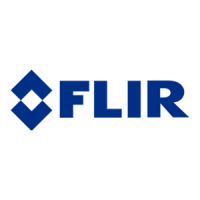7.7.4 Reflected apparent temperature
You are in a measurement situation where there are several hot sources that influence
your measurement. You need to have the right value for the reflected apparent tem-
perature to input into the camera and thus get the best possible correction. Do it in
this way: set the emissivity to 1.0. Adjust the camera lens to near focus and, looking
in the opposite direction away from the object, save one image. With the area or the
isotherm, determine the most probable value of the average of the image and use
that value for your input of reflected apparent temperature.
7.7.5 Object too far away
Are you in doubt that the camera you have is measuring correctly at the actual dis-
tance? A rule of thumb for your lens is to multiply the IFOV by 3. (IFOV is the detail
of the object seen by one single element of the detector). Example: 25 degrees cor-
respond to about 437 mrad. If your camera has a 120 × 120 pixel image, IFOV be-
comes 437/120 = 3.6 mrad (3.6 mm/m) and your spot size ratio is about
1000/(3 × 3.6)=92:1. This means that at a distance of 9.2 meters (30.2 ft.), your target
has to be at least about 0.1 meter or 100 mm wide (3.9"). Try to work on the safe side
by coming closer than 9 meters (30 ft.). At 7–8 meters (23–26 ft.), your measurement
should be correct.
7
40 Publ. No. 1558439 Rev. a156 – ENGLISH (EN) – February 28, 2006
7 – Introduction to thermographic inspections of electrical installations

